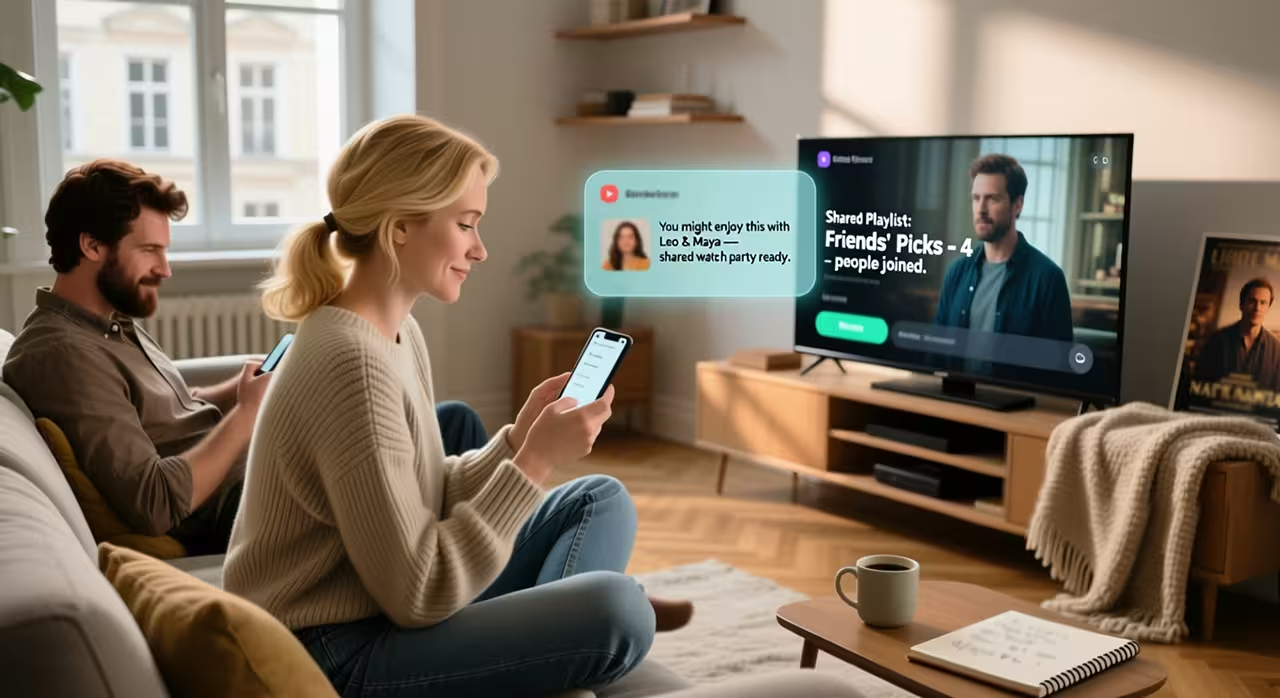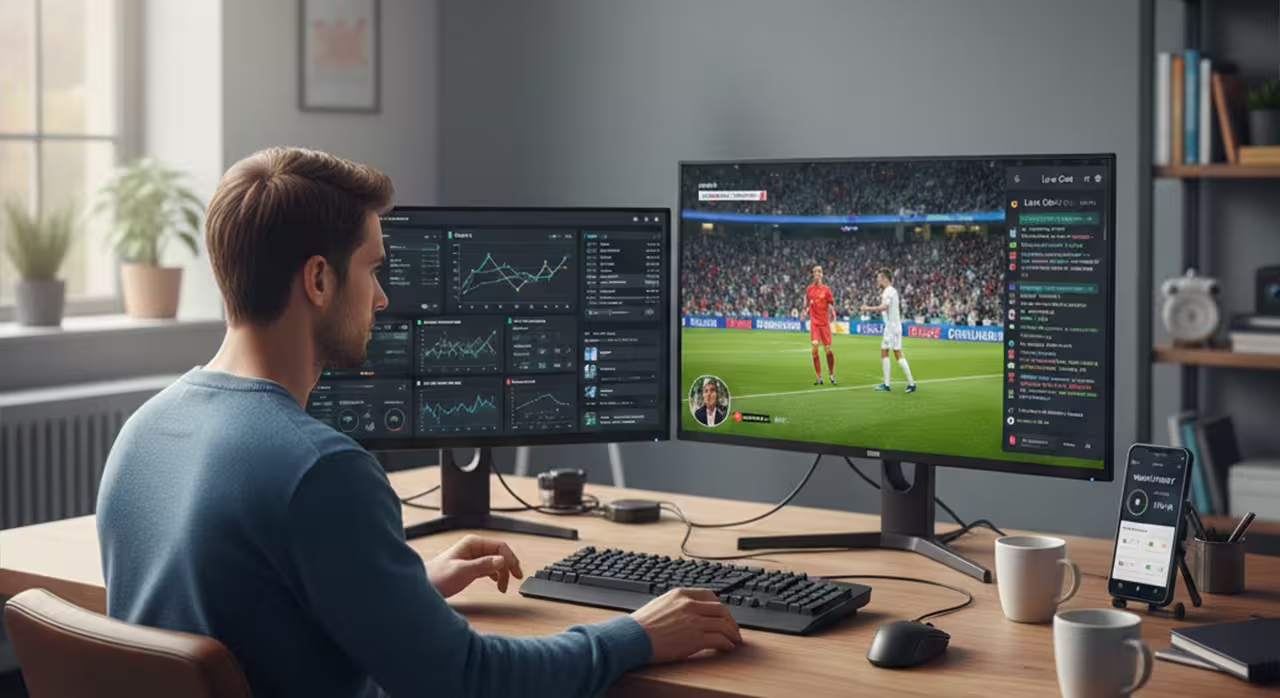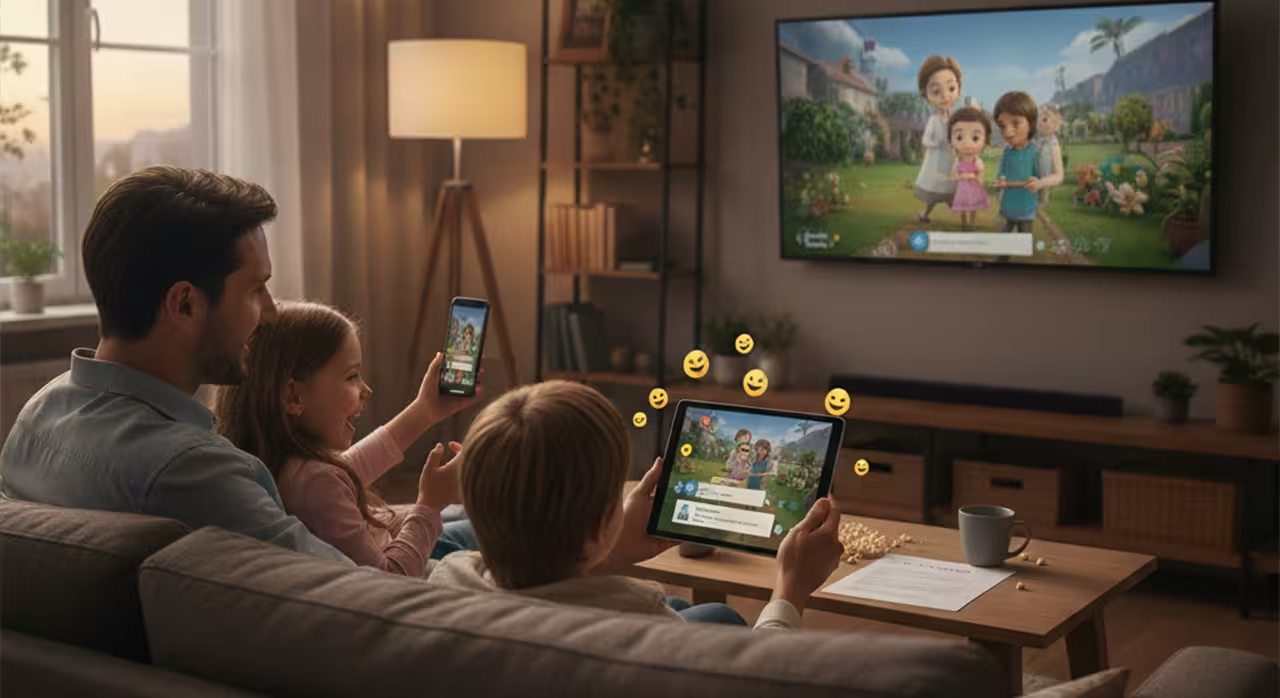
The Future of Social Connectivity in OTT: From Passive Watching to Shared Experiences
The way people consume content has fundamentally changed. Streaming is no longer a solitary experience. Viewers now crave social interactions while watching their favorite shows, sports events, and live broadcasts. OTT platforms are responding with social viewing experiences, making content more interactive and engaging than ever before.
Social connectivity is rapidly becoming a must-have feature in the OTT industry, with innovations like watch parties, synchronized playback, live chat, and AI-driven engagement tools leading the way. But what’s driving this change, and how can OTT providers capitalize on this trend?
Let’s explore the future of social connectivity in OTT and how it is reshaping user engagement.
Why Social Viewing Is on the Rise?
Social connectivity in OTT can be perceived as the evolution of an old habit. In the past, families and friends gathered in living rooms to watch TV together. Today, digital platforms allow viewers to recreate this shared experience online, despite being physically apart.
Key Drivers of Social Connectivity in OTT:
The Need for Shared Experiences

- People love to share live events, such as sports finals, season premieres, or concerts.
- Social platforms like Twitter and TikTok have proven that people enjoy discussing entertainment in real-time.
- Streamers on these platforms enhance the experience by hosting live giveaways or discussions, creating a more dynamic and engaging environment.
- Streaming services now integrate live chat, reactions, and social sharing to enhance communal viewing, offering flexibility in how users interact with each other.
- The interface of these platforms allows for seamless interaction, making shared experiences more accessible to audiences.
Technological Advancements

- Latest video streaming market trends shows faster internet speeds, higher bandwidth, and lower latency allow for real-time synchronization of streams.
- Google’s advancements in AI-powered video search help streamline content discovery, contributing to the customization of the viewing experience.
- Stream audio plays a crucial role in improving the viewing experience. With advancements in audio technologies, better sound quality leads to more immersive co-viewing, where stream audio can be synchronized across platforms for a seamless group experience.
- Cloud streaming with origin-edge hybrid architectures enables seamless, low-latency playback, making co-viewing smoother than ever, with minimal installation requirements for end-users.
AI-Driven Personalization and Engagement

- AI not only suggests what to watch but also who to watch with, based on social circles and viewing history, encouraging viewer subscriptions by offering highly tailored content.
- OTT platforms are incorporating customization features like personalized playlists and user-curated watch parties. By offering these tailored experiences, platforms are able to foster deeper viewer connections and enhance content discoverability.
- Advanced engagement features, like personalized chatrooms, interactive polls, and shared playlists, keep users engaged longer.
- Additionally, streaming platforms are constantly evolving their website content to include social features that align with viewer quests for better personalization and community-driven experiences.
How Leading Platforms Are Integrating Social Features

Several major OTT players have already embraced social connectivity to drive audience engagement:
- Amazon Prime Video Watch Party – Allows users to synchronize playback and chat in real-time while watching movies or TV shows together, enhancing the popularity of shared experiences.
- Disney+ GroupWatch – Users can watch the same content while sending emoji reactions and engaging in synchronized viewing, making it easy to share moments.
- YouTube Live Chat & Super Chat – Enables real-time interactions between content creators and audiences, making live streaming more dynamic. This is enhanced by YouTube's video embedding feature, which allows creators to share their streams across websites and blogs, further expanding their reach beyond the platform.
- Twitch Watch Parties – Merges gaming and social streaming, letting viewers engage through voice chat while watching content. This integration boosts audience engagement by creating more interactive experiences for users.
- Instagram Live – “Live Rooms” allow creators to go live with up to three guests, encouraging collaborative, interactive content, with a focus on building deeper connections among audiences.
This trend isn’t limited to entertainment. Sports, e-learning, and live shopping platforms are also integrating social features to increase engagement and retention.
Netflix UX Case Study: Why Social Viewing Is Hard to Get Right
Netflix has experimented with social features over the years but with mixed results. Early attempts included integrations with Facebook, allowing users to see what friends were watching. Netflix also used Facebook Live for promotional activity and cast Q&As, leveraging monetization opportunities through interactive fan engagement. These broadcast features helped drive real-time interaction but also highlighted the difficulties of integrating social elements seamlessly. However, concerns over privacy and fragmented user behaviors led Netflix to scale back these efforts, showing the challenges that even large platforms face when balancing social interaction and monetization.
More recently, Netflix tested limited watch party features through browser extensions like Teleparty, but never fully integrated this functionality into its core apps. UX researchers found three key friction points:
- Platform Fragmentation: Netflix operates on smart TVs, mobile apps, browsers, and set-top boxes. Ensuring synchronized playback and seamless social streaming technology across devices proved difficult, especially when accounting for latency differences and DRM protection.
- User Intent: Data revealed that not all users want interaction while watching. While Twitch audiences expect live chat streaming, many Netflix viewers prefer immersion and uninterrupted storytelling. Forcing social features without respecting intent risked alienating subscribers.
- Discovery & Entry Points: Netflix lacked clear OTT social media flows for joining or inviting friends to co-watch. Unlike Apple’s SharePlay, which integrates at the OS level through FaceTime, Netflix requires users to rely on third-party extensions, creating friction and reducing adoption.
Platform-Specific Features and Case Studies
Case studies reveal unique approaches. Twitch thrives on live chat streaming, where engagement is as important as content. YouTube’s SuperChat monetizes conversation, turning engagement into a revenue stream. Instagram Live enables co-hosting with up to four users, creating intimacy. Similarly, X Live formally Twitter Live allows for real-time discussions, making social interaction a key element of the viewing experience. TikTok Live, known for its interactive features, encourages audience participation through comments and live reactions, amplifying the sense of shared experience. The Netflix case shows that even the largest platforms face challenges with social viewing.
UX Lessons for OTT Operators
For smaller OTT operators, the key takeaway is to design with user intent in mind, prioritize simplicity, and consider phased rollouts starting with lightweight sharing before building advanced interactive streaming services.
- Make Social Optional: Social features should enhance, not disrupt, the core experience. A toggle or opt-in approach ensures wider acceptance.
- Leverage Existing Networks: Instead of building isolated systems, integration with OTT and social media platforms (e.g., WhatsApp or Messenger invites) can lower friction.
- Design for Cross-Platform Consistency: A successful watch party feature must work the same way across browsers, smart TVs, and mobile apps. Consistency builds trust and usage.
How OTT Operators Can Implement Social Features

Adding social tools is not just about user experience but also business growth. Operators can start small with social streaming technology, then scale to full-featured interactive streaming platforms.
Quick and Easy Approach: Social Sharing and Engagement Features
The simplest entry point is sharing. OTT apps can allow deep links to episodes, shareable timestamps, and previews optimized for OTT social media platforms. This creates organic discovery, encouraging users to invite friends. Social sharing requires minimal infrastructure but immediately increases reach and word-of-mouth growth.
Advanced Approach: Watch Party and Live Chat Integration
The next level is synchronous experiences. Built-in watch party feature options or integration with Apple’s SharePlay let users co-view across devices. Some platforms fall back on third-party tools like Teleparty or Scener. Regardless of the path, the goal is to replicate the living room virtually with synchronized playback and conversation.
Users Discover OTT Content on Social Media
Today, social streaming discovery often begins outside the app. Facebook groups organize binge-watch discussions, Reddit threads drive cult followings, LinkedIn groups facilitate professional content sharing and discussions, TikTok hashtags spread viral clips, and influencers post curated recommendations. Podcasts have also become a key medium, with creators discussing and recommending OTT content to their audiences. Deep links from posts to app playbacks reduce friction and turn social buzz into measurable OTT engagement.
Using Social Media to Market and Promote OTT
OTT operators can leverage external platforms for growth. For example, short-form promos on TikTok, Instagram Reels, and YouTube Shorts drive curiosity. Partnerships with creators expand reach, while trailer SEO ensures visibility.
To maximize the impact of paid social campaigns, a comprehensive checklist should be utilized. This checklist includes conducting A/B testing on advertisements to determine the most effective versions, implementing retargeting strategies to re-engage users who have previously interacted with your content, and creating lookalike audiences to reach new users who share characteristics with your existing customer base.
How Social Features Enable Advertising and Revenue
Social connectivity is a powerful revenue booster. AVOD and FAST platforms monetize via targeted ads during co-viewing. Shoppable streams allow direct purchases within events. Sponsor-driven watch parties create branded experiences. Merch sales can also be integrated into these events, allowing viewers to purchase branded products directly through live-streaming or watch parties, turning viewers into loyal fans and increasing monetization opportunities. Each of these interactive streaming services turns engagement into measurable revenue, blending entertainment and commerce.
OTT platforms are evolving into the destination for not just passive viewing but also social interaction and live community engagement. By integrating seamless chat features and live events, platforms can establish themselves as the go-to destination for entertainment and social bonding.
Data, Analytics, and Measuring Success
For OTT platforms, social features only deliver long-term value if they can be measured, analyzed, and optimized. Data is the backbone of proving ROI, improving user experiences, and ensuring that investments in social streaming technology translate into tangible business outcomes.
The first step is defining clear key performance indicators (KPIs). Traditional metrics such as average viewing time and subscriber growth remain important, but social features require more nuanced tracking. Engagement-driven KPIs might include the number of watch parties hosted per month, average party duration, messages sent in OTT chat, or the percentage of content shares across OTT and social media platforms. These measurements reveal how communities are interacting around the content.
Cohort analysis is another powerful tool. By grouping users based on their behavior such as those who use watch party features versus those who do not platforms can assess differences in churn rates, upsell conversions, and lifetime value. If data shows that users who engage in social OTT experiences remain subscribers longer, the business case for deeper social integration becomes clear.
Equally important is sentiment analysis within live chat or feedback loops. With advances in natural language processing, platforms can analyze the tone of conversations happening during live chat streaming, identifying spikes of excitement, frustration, or disengagement. This allows operators to refine content strategy, aligning programming decisions with audience mood and demand.
A/B testing remains a cornerstone of analytics. OTT operators can experiment with variations of social features such as offering synchronized reactions, personalized invitations, or second-screen interactions to determine which configurations drive higher engagement. These controlled experiments create a cycle of continuous improvement, ensuring features evolve in line with user preferences.
Finally, analytics play a crucial role in demonstrating value to advertisers. Brands investing in AVOD or FAST channels are no longer satisfied with broad reach alone; they want evidence of interactivity and attention. By providing metrics such as average co-viewing group size, click-through rates on shoppable streams, or branded watch party attendance, OTT operators can differentiate themselves as premium advertising partners.
Watch Parties: Tools, Limits, and How-Tos
Users need guidance. Hulu Watch Party allows up to 8 participants in browsers only. Teleparty works across Netflix, Disney+, and more, but requires a Chrome extension. Apple SharePlay integrates directly into iOS. Setting reasonable expectations is essential for adoption and satisfaction (device limits, participant caps, and UX design).
Platform and Tool Comparison
Live Streaming, Latency, and Interactivity

Behind the scenes, the choice of streaming protocols significantly impacts the delivery and interactivity of content. RTMP (Real-Time Messaging Protocol) is often used for contribution feeds, enabling broadcasters to ingest live video streams into their systems. For scalable playback to a wide audience, HLS (HTTP Live Streaming) is a popular choice, as it breaks video into small segments, allowing for adaptive bitrate streaming and broad device compatibility. WebRTC (Web Real-Time Communication) stands out for scenarios requiring ultra-low latency, such as live chat, interactive shows, or real-time bidding in auctions, by enabling peer-to-peer communication directly within web browsers.
Beyond protocols, Content Delivery Networks (CDNs) are crucial for minimizing buffering and ensuring smooth delivery by caching content geographically closer to users. Furthermore, second-screen integration enriches the user experience by allowing viewers to interact with content on a separate device, offering supplementary information, polls, or social engagement.
The optimal latency is a critical consideration and depends heavily on the content type. For high-stakes events like live sports, auctions, or interactive game shows where real-time reactions are paramount, ultra-low latency is vital. For other content, a higher latency might be acceptable if it allows for better quality or wider reach.
The Future of Social OTT: What’s Next?
Trends point to convergence. Creators are migrating from social platforms to OTT, especially on AVOD and FAST channels. Younger generations embrace interactive OTT, while older audiences stick to linear TV. Interactive streaming platforms will define the industry’s next phase, blending live events, commerce, and creator-led communities.
As technology advances, social streaming will become more immersive. Expect to see:
- Co-watching in Virtual Reality (VR) – Bringing people into shared virtual theaters.
- AI-powered agents – Personalized viewing experiences with AI-driven engagement.
- Interactive streaming events – Polls, real-time audience participation, and influencer-led watch sessions.
Social connectivity is becoming a core feature of OTT platforms that enhances retention, engagement, and user satisfaction.
At UniqCast, we help OTT providers stay ahead of industry trends, ensuring that their platforms are built for the next generation of interactive streaming.
Co-Viewing, Psychology, and Research

The concept of co-viewing has existed since the earliest days of television, when families gathered in living rooms to watch prime-time shows together.
Today, the practice extends into the digital sphere, where audiences share experiences both physically and virtually. Understanding the psychology behind co-viewing is crucial for OTT operators, because it explains why shared experiences create deeper ott engagement than solitary viewing.
Research from Nielsen shows that nearly half of all connected TV viewing in the United States is co-viewed, meaning more than one person is in the room while content plays.
This finding highlights the enduring importance of social presence in media consumption. Unlike passive solo viewing, co-viewing introduces conversation, shared reactions, and emotional bonding. For advertisers, this also means that a single stream often reaches multiple people. This is an important metric in measuring campaign impact and return on investment.
From a developmental perspective, studies by the Joan Ganz Cooney Center and the American Academy of Pediatrics emphasize the benefits of co-viewing for children. When parents and children watch content together, it encourages discussion, learning, and critical thinking. Educational programming becomes more effective when adults help interpret the material, turning entertainment into a joint learning experience.
In this way, social OTT and co-viewing experiences serve not only entertainment but also educational and developmental functions.
Psychologically, the value of co-viewing can be linked to the theory of social presence. This is the sense of being “with others” during an experience. Even in virtual contexts such as watch party features or live chat streaming, users report higher satisfaction and stronger emotional impact when they feel connected to others.
This effect is especially pronounced during live events, sports, or finales, where real-time reactions amplify the drama. OTT operators who successfully replicate this sense of social presence can create memorable, habit-forming experiences.
At the same time, hybrid viewing patterns are emerging. Many households now combine physical co-viewing with virtual interaction, such as chatting with friends on social media while sitting with family in the same room.
This dual-layered engagement demonstrates that viewers do not see “physical” and “virtual” co-viewing as separate but as complementary, and interactive overlays (real-time reactions, polls, synced chat windows and contextual info) are a key bridge between the two. For OTT providers, supporting ott and social media integrations ensures that their platforms remain at the center of this blended experience.
For product teams, the lesson is clear: designing for co-viewing is not just about technology but about psychology. Features like synchronized reactions, integrated ott chat, and second-screen trivia reinforce the human desire to connect through stories.
Final Thoughts: The OTT Experience Is Evolving
OTT no longer means watching alone. Social OTT features, from chat integration to watch parties, enhance engagement and deepen loyalty. For sellers and operators, these tools are not just UX add-ons but revenue drivers, retention engines, and marketing multipliers. Broadcasting content is no longer enough; platforms must facilitate meaningful social interactions to keep users invested.
The future of streaming belongs to platforms that connect, not just broadcast.




